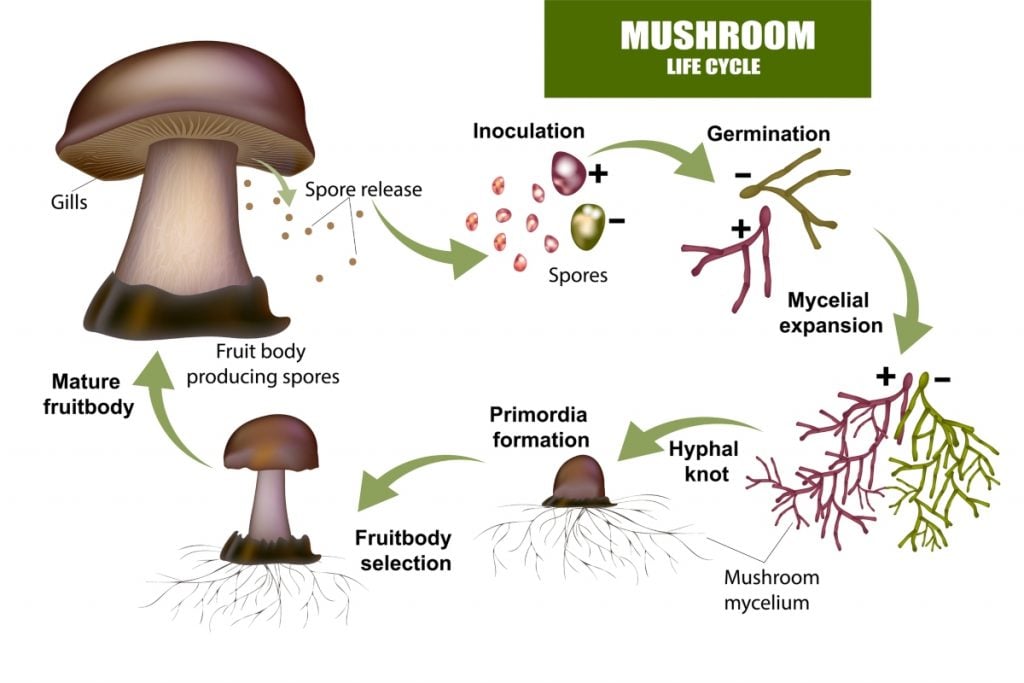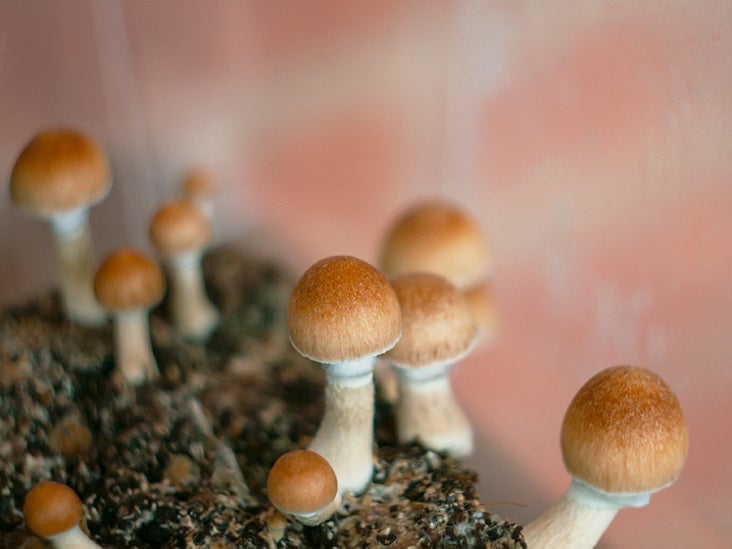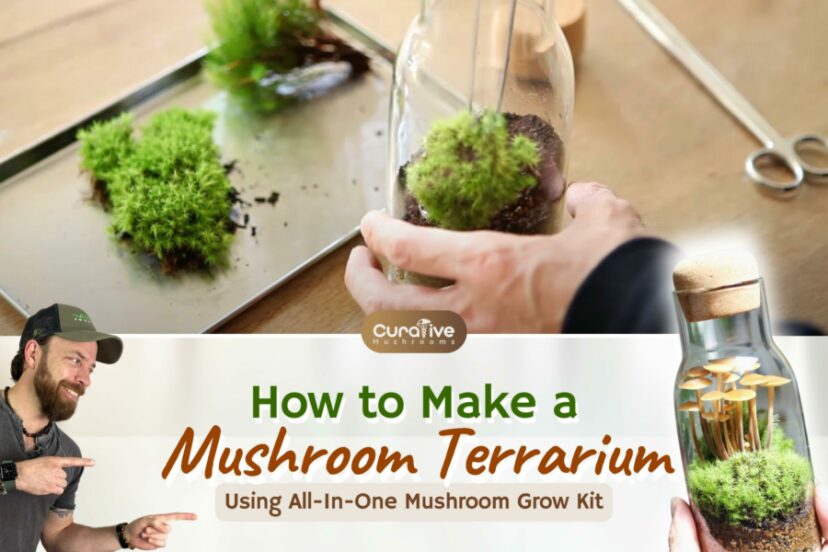Understanding the Life Cycle of Mushrooms
Mushrooms are the fruiting bodies of fungi, and their life cycle is crucial for understanding how to get spores from mushrooms. The life cycle of mushrooms consists of several stages, including spore germination, mycelium growth, and fruiting body formation. Spores are the primary means of reproduction for mushrooms, and they play a vital role in the life cycle of these organisms.
Spores are produced by mature mushrooms and are designed to withstand harsh environmental conditions. They can remain dormant for long periods, waiting for the right conditions to germinate. When a spore germinates, it produces a thread-like structure called a hypha, which grows into a network of mycelium. The mycelium breaks down organic matter and absorbs nutrients, allowing the fungus to grow and eventually produce fruiting bodies.
Understanding the life cycle of mushrooms is essential for successfully obtaining spores. By recognizing the different stages of the life cycle, you can identify the optimal time to harvest spores and ensure the highest quality and viability. For example, spores are typically produced by mature mushrooms, so it’s essential to wait until the mushrooms have fully developed before attempting to collect spores.
In addition to understanding the life cycle of mushrooms, it’s also important to recognize the different types of spores that are produced. Some mushrooms produce spores that are designed for long-distance dispersal, while others produce spores that are adapted for local dispersal. By understanding the characteristics of the spores you are working with, you can develop effective strategies for collecting and storing them.
By grasping the fundamentals of the mushroom life cycle and spore production, you’ll be well on your way to learning how to get spores from mushrooms. This knowledge will serve as a foundation for the more advanced techniques and strategies that will be discussed in subsequent sections.
Choosing the Right Mushroom Species for Spore Collection
When it comes to learning how to get spores from mushrooms, selecting the right species is crucial for success. Different mushroom species have unique characteristics, growth habits, and spore-producing abilities, making some more suitable for spore collection than others. In this section, we’ll explore some popular mushroom species that are well-suited for spore collection, including oyster, shiitake, and lion’s mane.
Oyster mushrooms (Pleurotus ostreatus) are a popular choice for spore collection due to their high spore production and ease of cultivation. They are also relatively easy to grow and can thrive in a variety of environments. Oyster mushrooms produce white, yellow, or gray spores, depending on the specific variety.
Shiitake mushrooms (Lentinula edodes) are another popular species for spore collection. They are native to East Asia and are prized for their rich, smoky flavor and meaty texture. Shiitake mushrooms produce brown or tan spores and are relatively easy to cultivate, making them a great choice for beginners.
Lion’s mane mushrooms (Hericium erinaceus) are a unique and fascinating species that are well-suited for spore collection. They produce white or cream-colored spores and have a distinctive appearance, with a cascading mass of long, white spines. Lion’s mane mushrooms are relatively easy to grow and can thrive in a variety of environments.
Other mushroom species that are suitable for spore collection include chanterelle, porcini, and morel. When selecting a mushroom species for spore collection, it’s essential to consider factors such as growth habits, spore production, and environmental requirements. By choosing the right species, you can increase your chances of success and obtain high-quality spores for further use.
Regardless of the species you choose, it’s essential to understand the specific characteristics and requirements of that species. This will help you to create an optimal environment for mushroom growth and spore production, which is critical for learning how to get spores from mushrooms.
Preparing Your Mushroom Cultivation Environment
Creating an optimal environment for mushroom cultivation is crucial for successful spore production and collection. To learn how to get spores from mushrooms, you’ll need to provide your mushrooms with the right conditions to grow and thrive. In this section, we’ll discuss the necessary equipment and environment for mushroom cultivation, including substrate, humidity, temperature, and light control.
Substrate is the material on which your mushrooms will grow. Common substrates include straw, compost, and wood chips. The choice of substrate will depend on the type of mushroom you’re growing and the desired level of nutrient availability. For example, oyster mushrooms can thrive on a wide range of substrates, while shiitake mushrooms prefer a more specific mix of sawdust and wood chips.
Humidity is another critical factor in mushroom cultivation. Most mushroom species require a humid environment to grow, typically between 70-90% relative humidity. You can maintain humidity levels using a humidifier or by covering the growing area with a damp cloth.
Temperature control is also essential for mushroom cultivation. Different species have optimal temperature ranges for growth, typically between 55-65°F (13-18°C). You can use a thermometer to monitor temperature levels and adjust as necessary.
Light control is also important for mushroom cultivation. While some species can tolerate direct light, others prefer low light or complete darkness. You can use shading materials or adjust the lighting schedule to provide the optimal light conditions for your mushrooms.
In addition to these environmental factors, you’ll also need to consider the equipment required for mushroom cultivation. This may include a growing chamber or terrarium, a heating mat or thermometer, and a humidifier or misting system. By investing in the right equipment and creating an optimal environment, you can increase your chances of success and learn how to get spores from mushrooms.
It’s also important to maintain a clean and sterile environment to prevent contamination and ensure healthy mushroom growth. This includes using sterile equipment, washing your hands regularly, and maintaining a clean growing area. By following these guidelines, you can create an optimal environment for mushroom cultivation and set yourself up for success in spore collection.
Harvesting Mushroom Spores: Techniques and Tools
Harvesting mushroom spores is a critical step in the process of learning how to get spores from mushrooms. To successfully collect spores, you’ll need to use the right techniques and tools. In this section, we’ll provide a step-by-step guide on how to harvest mushroom spores, including the use of spore prints, syringes, and other specialized tools.
Spore prints are a popular method for harvesting mushroom spores. To create a spore print, simply cut off the cap of a mature mushroom and place it gill-side down on a piece of paper or glass slide. Cover the mushroom with a glass or bowl to create a humid environment, and let it sit for 24-48 hours. The spores will fall from the mushroom and create a print on the paper or glass slide.
Syringes are another tool used for harvesting mushroom spores. To use a syringe, simply fill it with water and insert the needle into the gills of a mature mushroom. Gently pull back on the plunger to create suction, and the spores will be drawn into the syringe. This method is particularly useful for collecting spores from mushrooms with small or delicate gills.
In addition to spore prints and syringes, there are several other tools and techniques that can be used for harvesting mushroom spores. These include spore traps, which use a combination of heat and humidity to collect spores, and spore collectors, which use a series of small tubes and filters to collect and separate spores.
Regardless of the method or tool used, it’s essential to maintain proper technique and sanitation to ensure spore viability. This includes using sterile equipment, washing your hands regularly, and maintaining a clean and humid environment. By following these guidelines, you can successfully harvest mushroom spores and take the next step in learning how to get spores from mushrooms.
It’s also important to note that different mushroom species may require different harvesting techniques. For example, some species may produce spores that are more easily collected using a spore print, while others may require the use of a syringe or other specialized tool. By understanding the specific needs and characteristics of the mushroom species you’re working with, you can optimize your harvesting technique and improve your chances of success.
Isolating and Purifying Mushroom Spores
Isolating and purifying mushroom spores is a critical step in the process of learning how to get spores from mushrooms. To successfully isolate and purify spores, you’ll need to use specialized equipment and techniques. In this section, we’ll explain the process of isolating and purifying mushroom spores, including the use of agar plates, microscopes, and other laboratory equipment.
Agar plates are a common tool used for isolating and purifying mushroom spores. To use an agar plate, simply spread a small amount of spore print or spore suspension onto the surface of the plate. Incubate the plate in a warm, humid environment, and the spores will begin to germinate and grow. Once the spores have germinated, you can use a microscope to examine the plate and identify individual spores.
Microscopes are an essential tool for isolating and purifying mushroom spores. To use a microscope, simply place a small sample of spore print or spore suspension onto a glass slide. Add a few drops of water or other liquid to the slide, and cover it with a glass cover slip. Examine the slide under the microscope, and use a sterile needle or other tool to isolate individual spores.
In addition to agar plates and microscopes, there are several other techniques and equipment that can be used for isolating and purifying mushroom spores. These include the use of spore traps, which use a combination of heat and humidity to collect spores, and spore collectors, which use a series of small tubes and filters to collect and separate spores.
Regardless of the method or equipment used, it’s essential to maintain a sterile environment to prevent contamination. This includes using sterile equipment, washing your hands regularly, and maintaining a clean and humid environment. By following these guidelines, you can successfully isolate and purify mushroom spores and take the next step in learning how to get spores from mushrooms.
It’s also important to note that different mushroom species may require different isolation and purification techniques. For example, some species may require the use of specialized media or equipment, while others may require a specific temperature or humidity level. By understanding the specific needs and characteristics of the mushroom species you’re working with, you can optimize your isolation and purification technique and improve your chances of success.
Storing and Preserving Mushroom Spores for Future Use
Once you have successfully harvested and isolated mushroom spores, it’s essential to store and preserve them properly to maintain their viability and prevent degradation over time. In this section, we’ll discuss the best practices for storing and preserving mushroom spores, including the use of refrigeration, freezing, and desiccation.
Refrigeration is a common method for storing mushroom spores. To store spores in the refrigerator, simply place them in a sealed container or bag and keep them at a consistent temperature between 39°F and 45°F (4°C and 7°C). This will slow down the metabolic processes of the spores and help to maintain their viability.
Freezing is another effective method for storing mushroom spores. To freeze spores, simply place them in a sealed container or bag and store them in a freezer at a temperature of 0°F (-18°C) or lower. This will put the spores into a state of dormancy, allowing them to remain viable for extended periods.
Desiccation is a third method for storing mushroom spores. To desiccate spores, simply place them in a sealed container or bag and store them in a dry, cool environment. This will remove the moisture from the spores, allowing them to remain viable for extended periods.
Regardless of the method used, it’s essential to maintain proper storage and handling techniques to prevent contamination and degradation. This includes using sterile equipment, washing your hands regularly, and maintaining a clean and dry environment. By following these guidelines, you can successfully store and preserve mushroom spores and maintain their viability for future use.
It’s also important to note that different mushroom species may require different storage and preservation techniques. For example, some species may require a specific temperature or humidity level, while others may require a particular type of storage container. By understanding the specific needs and characteristics of the mushroom species you’re working with, you can optimize your storage and preservation technique and improve your chances of success.
By following the guidelines outlined in this article, you can successfully store and preserve mushroom spores and maintain their viability for future use. This will allow you to continue learning how to get spores from mushrooms and to expand your knowledge and skills in this area.
Troubleshooting Common Issues in Mushroom Spore Collection
When learning how to get spores from mushrooms, it’s not uncommon to encounter issues that can impact the success of your spore collection efforts. In this section, we’ll address common issues that may arise during mushroom spore collection, including contamination, poor spore production, and equipment malfunctions. We’ll also provide troubleshooting tips and solutions to help you overcome these challenges.
Contamination is a common issue that can occur during mushroom spore collection. This can happen when bacteria, mold, or other microorganisms enter the spore collection environment and begin to grow. To prevent contamination, it’s essential to maintain a sterile environment and use proper sanitation techniques. This includes washing your hands regularly, using sterile equipment, and maintaining a clean and dry environment.
Poor spore production is another issue that can impact the success of your spore collection efforts. This can happen when the mushroom species is not producing spores, or when the spores are not being collected properly. To address this issue, it’s essential to understand the specific needs and characteristics of the mushroom species you’re working with. This includes providing the right environment, substrate, and nutrients to support spore production.
Equipment malfunctions are also a common issue that can occur during mushroom spore collection. This can happen when the equipment used for spore collection is not functioning properly, or when it’s not being used correctly. To address this issue, it’s essential to regularly inspect and maintain your equipment, and to follow proper usage guidelines.
By understanding the common issues that can arise during mushroom spore collection, you can take steps to prevent them and ensure the success of your spore collection efforts. This includes maintaining a sterile environment, understanding the specific needs and characteristics of the mushroom species you’re working with, and regularly inspecting and maintaining your equipment.
Additionally, it’s essential to stay calm and patient when encountering issues during mushroom spore collection. This can help you to think clearly and come up with creative solutions to overcome the challenges you’re facing. By staying calm and patient, you can ensure the success of your spore collection efforts and continue to learn how to get spores from mushrooms.
Advanced Techniques for Mushroom Spore Collection and Research
For those who want to take their mushroom spore collection and research to the next level, there are several advanced techniques that can be employed. These techniques include the use of molecular biology and genetic analysis, which can help to improve spore quality, yield, and consistency.
Molecular biology techniques, such as PCR (polymerase chain reaction) and DNA sequencing, can be used to identify and characterize mushroom species at the molecular level. This can help to ensure that the spores being collected are from the desired species and can also provide information on the genetic diversity of the species.
Genetic analysis techniques, such as genotyping and phenotyping, can be used to study the genetic characteristics of mushroom species and to identify genetic markers that are associated with desirable traits. This can help to improve the quality and consistency of the spores being collected and can also provide information on the genetic diversity of the species.
Other advanced techniques that can be employed in mushroom spore collection and research include the use of automated systems for spore collection and processing, and the use of computer-aided design and simulation tools to optimize spore collection and processing protocols.
By employing these advanced techniques, researchers and mushroom enthusiasts can gain a deeper understanding of the biology and genetics of mushroom species and can develop more efficient and effective methods for collecting and processing spores. This can help to improve the quality and consistency of the spores being collected and can also provide new insights into the biology and genetics of mushroom species.
Additionally, these advanced techniques can also be used to develop new products and technologies related to mushroom spores, such as novel spore-based products for agriculture, medicine, and other industries.
Overall, the use of advanced techniques in mushroom spore collection and research can help to unlock the full potential of these fascinating organisms and can provide new opportunities for scientific discovery and innovation.







